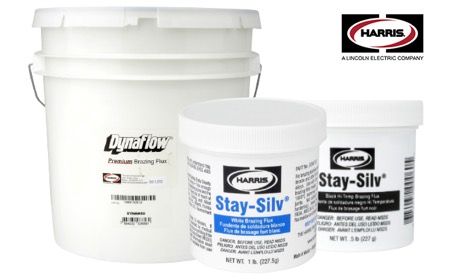
STAY-SILV WHITE BRAZING FLUX
This is a white paste flux that’s used for 90% of silver brazing applications. White flux is useful for brazing copper, brass, steel, stainless steel and nickel alloys. It has an active temperature range of 1050° -1600°F (565° – 870°C). Use it with the Safety-Silv® high silver brazing filler metals (AWS BAg series) on the above base metals, and the Stay-Silv® phos-copper-silver (AWS BCuP series) on copper to brass.
White flux conforms to American Welding Society (AWS) specification A5.31, class FB3-A.
STAY-SILV POWDER BRAZING FLUX
This is similar to the white flux except in a powder form. Since it’s a powder it will not separate or harden during storage (keep lid tightly closed as the flux will draw air moisture). The flux can be used in its powder form by heating the end of the brazing rod or wire and dipping it in the flux. The flux will adhere to the heated rod. The flux can also be mixed as needed with water or alcohol to form a paste. The paste can be applied to the part prior to brazing.
This flux conforms to AWS A5.31 class FB3-F and has a temperature range of 1200 – 1600°F (650 – 870°C).
DYNAFLOW AUTO DISPENSING FLUX
Fluxes are chemical mixtures that contain varying size particles. Flux application can sometimes be automated on multiple station brazing machines. For automated flux dispensing equipment these particles must be held below a minimum size to prevent clogging orifices and lines. Dynaflow flux was originally developed as a “smoother” flux to facilitate automated feeding. This consistency is developed by introducing an additional step during the manufacturing process. The smoother consistency also reduces fluid separation inside unused containers.
DYNAFLOW FLUX is used for similar brazing applications as the standard white flux.
STAY-SILV BLACK BRAZING FLUX
The black flux formula includes powdered boron which gives the flux a black color. This ingredient provides two features:
A. Flux absorbs oxide during heating. There is a maximum amount of oxide absorption the flux provides, after which it becomes saturated and is no longer effective. This formulation allows the flux to withstand longer heating cycles without breaking down. These applications may include specific types of concentrated localized heating (induction, for example), or may occur during torch heating of large parts. In these cases the black brazing flux is a good choice.
B. Some metal oxides are more difficult to flux. These include stainless steel, nickel alloys and tungsten carbide. The black flux helps dissolve these oxides and assists in filler metal wetting.
BLACK FLUX is primarily used with the Safety-Silv high silver brazing filler metals (you’ll often find it used with the nickel containing 40Ni2 or 50N products).
Black flux conforms to AWS A5.31 class FB3-C and has an active temperature range of about 1050 – 1700°F (565 – 925°C).
